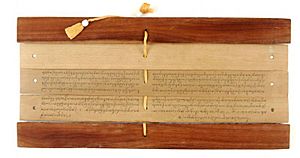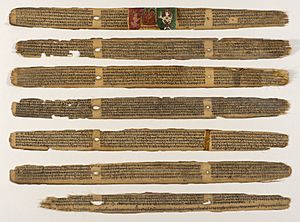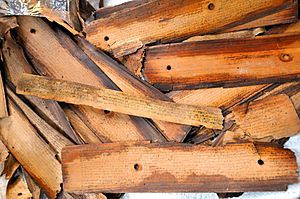Palm-leaf manuscript facts for kids
Palm leaf manuscripts are ancient books or documents made by writing on dried palm leaves. People in Southeast Asia started using palm leaves for writing a very long time ago, possibly even before 500 BC!
To make a palm leaf ready for writing, it was first cooked, then dried, and finally polished. Because of how palm leaves grow, these manuscripts usually look wide and short, like a landscape picture. They are typically about 15 centimetres (5.9 in) to 60 centimetres (24 in) wide, but only 3 centimetres (1.2 in) to 12 centimetres (4.7 in) tall.
Over time, these old manuscripts can get damaged. They might rot or be eaten by tiny insects called silverfish. This is why it's so important to protect and preserve them!
Contents
What are Palm Leaf Manuscripts?
Palm leaf manuscripts are like very old books or documents. Instead of paper, they are made from the leaves of palm trees. People used them to write down stories, religious texts, scientific knowledge, and more.
How They Were Made
Making a palm leaf manuscript was a careful process:
- First, the fresh palm leaves were picked.
- Then, they were cooked in water. This made them flexible and durable.
- After cooking, the leaves were dried, often in the sun.
- Finally, they were polished to create a smooth surface for writing.
Once the leaves were ready, people would write on them using a sharp tool to scratch the letters into the leaf. Then, ink or charcoal dust was rubbed into the scratches to make the writing stand out.
The Shape of the Manuscripts
Have you ever noticed how a palm leaf is long and thin? Because of this, the manuscripts made from them are also long and thin. This is called a "landscape format." Imagine a wide picture frame; that's similar to how these manuscripts look. They are much wider than they are tall.
Why Palm Leaf Manuscripts are Important
Palm leaf manuscripts are very important because they hold a lot of history and knowledge. They tell us about the beliefs, stories, and science of ancient times. Many old texts from countries like India, Sri Lanka, and other parts of Southeast Asia were preserved on these leaves.
Keeping Them Safe
Because palm leaves are natural materials, they can get damaged over time. They might rot, or small insects like silverfish can eat them. This is why museums and libraries work hard to protect these precious manuscripts. They keep them in special conditions to make sure they last for many more years.


Images for kids
-
A medical manuscript in Sinhala, from c. 1700.
-
A Balinese palm-leaf manuscript of Kakawin Arjunawiwāha.
See also
 In Spanish: Manuscritos de hoja de palma para niños
In Spanish: Manuscritos de hoja de palma para niños










